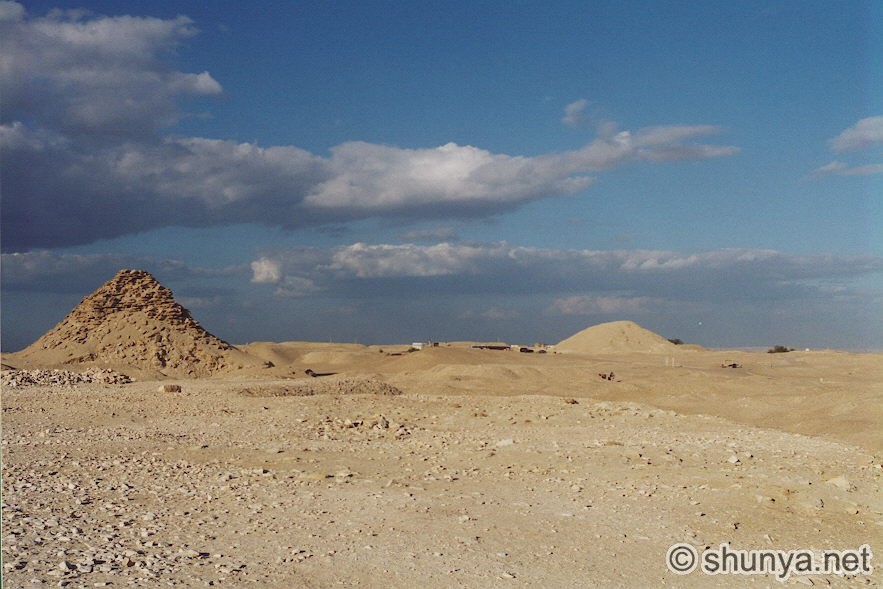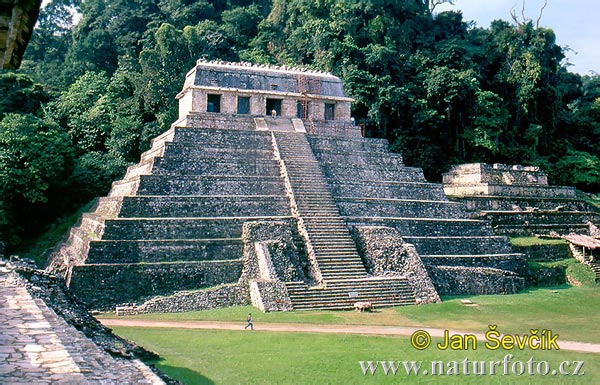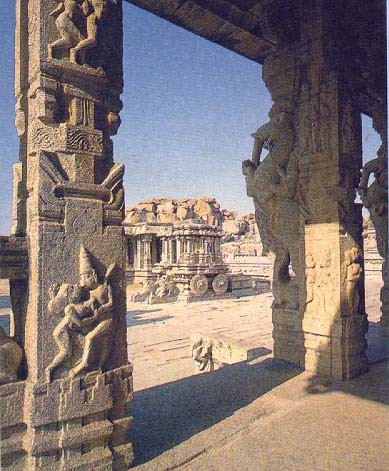
MACHU PICCHU (Peru): The Lost City of the Incas [
Wiki]
Machu Picchu ("Old Peak") is a pre-Columbian Inca city located at 2,430 m (7,970 ft) altitude on a mountain ridge above the Urubamba Valley in Peru, near Cusco. Machu Picchu is probably the most familiar symbol of the Inca Empire. It is often referred to as "The Lost City of the Incas". The site was designated as a World Heritage Site in 1983 when it was described as "an absolute masterpiece of architecture and a unique testimony to the Inca civilization".
Machu Picchu was constructed around 1450, at the height of the Inca empire, and was abandoned less than 100 years later, as the empire collapsed under Spanish conquest. Although the citadel is located only about 50 miles from Cusco, the Inca capital, it was never found and destroyed by the Spanish, as were many other Inca sites. Over the centuries, the surrounding jungle grew to enshroud the site, and few knew of its existence. In 1911, Yale historian and explorer Hiram Bingham brought the "lost" city to the world's attention. Bingham and others hypothesized that the citadel was the traditional birthplace of the Inca people or the spiritual center of the "virgins of the sun," while curators of a recent exhibit have speculated that Machu Picchu was a royal retreat.

ANGKOR (Cambodia): Contains the world's largest religious monument [
Wiki]
Angkor served as the seat of the Khmer empire that flourished from approximately the 9th century to the 15th century A.D. More precisely, the Angkorian period may be defined as the period from 802 A.D., when the Khmer Hindu monarch Jayavarman II declared himself the "universal monarch" and "god-king" of Cambodia, until 1431 A.D., when Thai invaders sacked the Khmer capital, causing its population to migrate south to the area of Phnom Penh. The ruins of Angkor are located amid forests and farmland to the north of the Great Lake (Tonle Sap) and south of the Kulen Hills, near modern day Siem Reap (13°24'N, 103°51'E), and are a UNESCO World Heritage Site. The temples of the Angkor area number over one thousand, ranging in scale from nondescript piles of brick rubble scattered through rice fields to the magnificent Angkor Wat, said to be the world's largest single religious monument. Many of the temples at Angkor have been restored, and together they comprise the most significant site of Khmer architecture. Visitor numbers approach one million annually.
In 2007 an international team of researchers using satellite photographs and other modern techniques concluded that Angkor had been the largest preindustrial city in the world with an urban sprawl of 1,150 square miles. The closest rival to Angkor, the Mayan city of Tikal in Guatemala, was roughly 50 square miles in total size.

MEMPHIS (Egypt): ancient capital of Egypt[
Wiki]
Memphis was the ancient capital of the first nome of Lower Egypt, and of the Old Kingdom of Egypt from its foundation until around 2200 BC and later for shorter periods during the New Kingdom, and an administrative centre throughout ancient history. Its Ancient Egyptian name was Ineb Hedj ("The White Walls"). The name "Memphis" is the Greek deformation of the Egyptian name of Pepi I's (6th dynasty) pyramid, Men-nefer, which became Menfe in Coptic. According to Herodotus, the city was founded around 3100 BC by Menes, who united the two kingdoms of Egypt.
Estimates of population size differ widely. According to T. Chandlerm, Memphis had some 30,000 inhabitants and was by far the largest settlement worldwide from the time of its foundation until around 2250 BC and from 1557 to 1400 BC. Memphis reached a peak of prestige under the 6th Dynasty as a centre of the cult of Ptah. It declined briefly after the 18th Dynasty with the rise of Thebes and was revived under the Persian satraps before falling firmly into second place following the foundation of Alexandria. Under the Roman Empire, Alexandria remained the most important city and Memphis remained the second city of Egypt until the establishment of Fustat (or Fostat) in 641. It was then largely abandoned and became a source of stone for the surrounding settlements. It was still an imposing set of ruins in the 12th century but soon became little more than an expanse of low ruins and scattered stone. The remains of the temple of Ptah and of Apis have been uncovered at the site as well as a few statues, including two four-metre ones in alabaster of Ramesses II. The Saqqara necropolis is close to Memphis.

PETRA: stone structures carved into rocks [
Wiki]
Petra ("Rock") lies on the slope of Mount Hor (Jordan) in a basin among the mountains which form the eastern flank of Arabah (Wadi Araba), the large valley running from the Dead Sea to the Gulf of Aqaba. It is famous for having many stone structures carved into the rock. The long-hidden site was revealed to the Western world by the Swiss explorer Johann Ludwig Burckhardt in 1812. It was famously described as "a rose-red city half as old as time" in a Newdigate prize-winning sonnet by John William Burgon. Burgon had not actually visited Petra, which remained accessible only to Europeans accompanied by local guides with armed escorts until after World War I. The site was designated as a UNESCO World Heritage Site in 1985 when it was described as "one of the most precious cultural properties of man's cultural heritage." Enclosed by towering rocks and watered by a perennial stream, Petra not only possessed the advantages of a fortress but controlled the main commercial routes which passed through it to Gaza in the west, to Bosra and Damascus in the north, to Aqaba and Leuce Come on the Red Sea, and across the desert to the Persian Gulf. Petra's decline came rapidly under Roman rule, in large part due to the revision of sea-based trade routes. In 363 an earthquake destroyed buildings and crippled the vital water management system. The ruins of Petra were an object of curiosity in the Middle Ages and were visited by the Sultan Baibars of Egypt towards the close of the 13th century. The first European to describe them was Johann Ludwig Burckhardt in 1812.

PALMYRA (Syria): the Bride of the Desert [
Wiki]
Palmyra was in the ancient times an important city of central Syria. It has long been a vital caravan city for travellers crossing the Syrian desert and was known as the Bride of the Desert. The earliest documented mention of the city by its pre-Semitic name Tadmor, Tadmur or Tudmur, is recorded in Babylonian tablets found in Mari. Though the ancient site fell into disuse after the 16th century, it is still known as Tadmor and there is a small newer settlement next to the ruins of the same name.
n the mid-first century, Palmyra, a wealthy and elegant city located along the caravan routes linking Persia with the Mediterranean ports of Roman Syria and Phoenicia, came under Roman control. During the following period of great prosperity, the Arab citizens of Palmyra adopted customs and modes of dress from both the Iranian Parthian world to the east and the Graeco-Roman west. Tadmor is mentioned in the Hebrew Bible (Second Book of Chronicles 8:4) as a desert city built by the King Solomon of Judea, the son of David. Palmyra was made part of the Roman province of Syria during the reign of Tiberius (14–37). It steadily grew in importance as a trade route linking Persia, India, China, and the Roman empire. In 634 the first Muslims arrived in Palmyra. The city was taken by the Muslim Arabs under Khalid ibn Walid in 636. In the 6th century, Fakhreddine al Maany castle was built on top of a mountain overlooking the oasis. The castle was surrounded by a moat, with access only available through a drawbridge. The city of Palmyra was kept intact. After year 800, people started abandoning the city.

POMPEII (Italy): one of the petrified victims
Wiki]
Along with Herculaneum, this Roman city near modern Naples was destroyed and completely buried during a catastrophic eruption of the volcano Mount Vesuvius spanning two days on 24 August year 79. The volcano collapsed higher roof-lines and buried Pompeii under many meters of ash and pumice, and it was lost for nearly 1700 years before its accidental rediscovery in 1748.
Since then, its excavation has provided an extraordinarily detailed insight into the life of a city at the height of the Roman Empire. Today, it is one of the most popular tourist attractions of Italy and a UNESCO World Heritage Site.

PALENQUE (Mexico): one of Mayan's most exquisite cities [
Wiki]
Palenque is an ancient Maya city near the Usumacinta River in the Mexican state of Chiapas. It contains some of the finest architecture, sculpture, roof comb and bas-relief carvings the Maya produced. The ancient Mayan city of Palenque, with its superb jungle setting and exquisite architecture and decoration, is one of the marvels of Mexico. First occupied around 100 BC, it flourished from about 600 to 700 AD, and what a glorious century that was. The city rose to prominence under Pakal, a club-footed king who reigned from 615 to 683 AD, represented by hieroglyphs of sun and shield, he is also referred to as Sun Shield or White Macaw. During Pakal's reign, many plazas and buildings, including the superlative Templo de las Inscripciones (his Mausoleum), were constructed in Palenque, characterized by very fine stucco bas-reliefs.
Pakal's son Chan-Bahlum II continued Palenque's political and economic expansion and the development of its art and architecture and presided over the construction of the Grupo de la Cruz temples, placing sizable narrative stone stelae within each. One can see the influence of Palenque's architecture in the Mayan city of Tikal. The rival Mayan city of Toniná's hostility was perhaps the major factor in Palenque's precipitous decline after Chan-Bahlum II's death in 702. Sources speak of a devastating Toniná attack on Palenque in 730. After the 10th century Palenque was largely abandoned. In an area that receives the heaviest rainfall in Mexico, the ruins lay undiscovered until the 18th century. Frans Blom, an early-to-mid-20th century investigator remarked: 'The first visit to Palenque is immensely impressive. When one has lived there for some time this ruined city becomes an obsession.'

VIJAYANAGAR (India): capital of one of the largest Hindu empires [
Wiki]
Vijayanagar, the capital of one of the largest Hindu empires ever, was founded by Sangama dynasty princes Harihara and Bukka in 1336. Its power peaked under Krishnadevaraya (1509-29), when it controlled nearly the whole of the peninsula south of the Krishna and Tungabhadra rivers. Comparable to Delhi in the 14th century, the city, with an estimated population of half a million, covered 33 sq km and was surrounded by several concentric lines of fortification. Its wealth derived from the control of spice trade and the cotton industry. Its busy bazaars, described by travelers such as Portuguese Nunez and Paes, were centers of international commerce. The empire collapsed after the battle of Talikota in 1565 when the city was ransacked by the confederacy of Deccan sultans (Bidar, Bijapur, Golconda, Ahmednagar and Berar), thus opening up southern India for Muslim conquest.
The ruins are set in a strange and beautiful boulder strewn landscape with an almost magical quality. The undisputed highlight, the 16th century Vittala Temple, is a World Heritage Monument. Started by Krishnadevaraya, it was never finished or consecrated; its incredible sculptural work is the pinnacle of Vijayanagar art. The outer pillars are known as musical pillars as they reverberate when tapped. An ornate stone chariot in the temple courtyard containing an image of Garuda.

EPHESUS (Turkey): one of the most important cities of early Christianity [
Wiki]
Ephesus was an Ionian Greek city in ancient Anatolia, founded by colonists from Athens in the 10th century BC. The city was located in Ionia, where the Cayster River (Küçük Menderes) flows into the Aegean Sea, and was part of the Panionian League. Ephesus hosted one of the seven churches of Asia, addressed in the Book of Revelation (2:1–7). It is also the site of a large Gladiator graveyard.
Ephesus was an important center for early Christianity. Paul used it as a base. He became embroiled in a dispute with artisans, whose livelihood depended on the Temple of Artemis there (Acts 19:23–41), and wrote 1 Corinthians from Ephesus. Later Paul wrote to the Christian community at Ephesus.

SANCHI (India): the best-preserved group of Buddhist monuments [
Wiki]
A UNESCO world heritage site in central India near the Betwa River, Sanchi is on a flat-topped sandstone hill, 90m above the countryside, and stands the best-preserved group of Buddhist monuments in India. Most noteworthy is the Great Stupa, discovered in 1818. It was probably begun by the emperor Asoka in the mid-3rd century BCE and later enlarged. Solid throughout, it is enclosed by a massive stone railing pierced by four gateways on which are elaborate carvings depicting the life of the Buddha.
The stupa itself consists of a base bearing a hemispherical dome representing the dome of heaven enclosing the Earth; it is surmounted by a squared rail unit, the world mountain, from which rises a mast to symbolize the cosmic axis. The mast bears umbrellas that represent the various heavens. Other remains include several smaller stupas, an assembly hall (caitya), an Asokan pillar with inscription, and several monasteries (4th–11th cent. CE). Several relic baskets and more than 400 epigraphical records have also been discovered.
 Latte art or coffee art refers to designs created on the tops of espresso based drinks by a barista. These designs are usually created in one of two ways and sometimes using a combination of both. The first method is by manipulating the flow of milk from a jug into the espresso (known as free pour latte art). The second is by drawing designs with an implement (known as etching), using stencils, powders and milk foam. Latte art is most commonly seen on a latte, although it can also be part of the presentation of a cappuccino, a caffe mocha or even an espresso macchiato. As the popularity of premium espresso-based drinks has risen, the craft of garnishing through latte art has as well. Here's a sample of the very best of this technique!
Latte art or coffee art refers to designs created on the tops of espresso based drinks by a barista. These designs are usually created in one of two ways and sometimes using a combination of both. The first method is by manipulating the flow of milk from a jug into the espresso (known as free pour latte art). The second is by drawing designs with an implement (known as etching), using stencils, powders and milk foam. Latte art is most commonly seen on a latte, although it can also be part of the presentation of a cappuccino, a caffe mocha or even an espresso macchiato. As the popularity of premium espresso-based drinks has risen, the craft of garnishing through latte art has as well. Here's a sample of the very best of this technique!

 Ummm...Maybe not the last one.
Ummm...Maybe not the last one.







 AquaDom: world's largest cylindrical aquarium-Placed at the lobby of the Radisson SAS Hotel in Berlin, the 25 meters high AquaDom is the largest cylindrical aquarium ever built. Filled with about 900,000 liters of seawater, it contains some 2600 fish of 56 species. Combined with a vast amount of sandblasted glass, the giant AquaDom gives a transparent-like feeling to the lobby. Guests and visitors are able to travel through the aquarium in a glass-enclosed elevator to reach a sightseeing point and restaurant under the glass roof. Two full-time divers are responsible for the care and feeding of the fish and maintenance of the aquarium. The AquaDom was opened in December 2003. It cost about 12.8 million euros.
AquaDom: world's largest cylindrical aquarium-Placed at the lobby of the Radisson SAS Hotel in Berlin, the 25 meters high AquaDom is the largest cylindrical aquarium ever built. Filled with about 900,000 liters of seawater, it contains some 2600 fish of 56 species. Combined with a vast amount of sandblasted glass, the giant AquaDom gives a transparent-like feeling to the lobby. Guests and visitors are able to travel through the aquarium in a glass-enclosed elevator to reach a sightseeing point and restaurant under the glass roof. Two full-time divers are responsible for the care and feeding of the fish and maintenance of the aquarium. The AquaDom was opened in December 2003. It cost about 12.8 million euros. 
 Toilet Aquarium-Teach a man to fish, and you have fed him for a lifetime. Put some fish in a man's toilet, and he will never have a boring trip to the pot again. This is the clever thinking behind the Fish 'n Flush. Fish 'n Flush is a patented, two-piece aquarium toilet tank, designed by AquaOne Technologies, Inc., an innovator of water-management systems. The aquarium has a 2.2-gallon capacity. When you flush, it looks like all the water is draining out of the tank and the fish are going down, but it's an optical illusion: the fish are actually safe in an outer aquarium made of high-polished plastic. What you see draining is the toilet water in a separate tank behind the aquarium.
Toilet Aquarium-Teach a man to fish, and you have fed him for a lifetime. Put some fish in a man's toilet, and he will never have a boring trip to the pot again. This is the clever thinking behind the Fish 'n Flush. Fish 'n Flush is a patented, two-piece aquarium toilet tank, designed by AquaOne Technologies, Inc., an innovator of water-management systems. The aquarium has a 2.2-gallon capacity. When you flush, it looks like all the water is draining out of the tank and the fish are going down, but it's an optical illusion: the fish are actually safe in an outer aquarium made of high-polished plastic. What you see draining is the toilet water in a separate tank behind the aquarium. 






























 MACHU PICCHU (Peru): The Lost City of the Incas [
MACHU PICCHU (Peru): The Lost City of the Incas [








